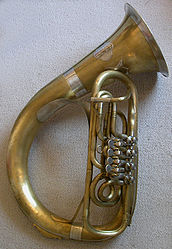music.wikisort.org - Instrument
The helicon is a brass musical instrument in the tuba family. Most are B♭ basses, but they also commonly exist in E♭, F, and tenor sizes, as well as other types to a lesser extent.
 | |
| Brass instrument | |
|---|---|
| Classification |
|
| Hornbostel–Sachs classification | 423.232 (Valved aerophone sounded by lip movement) |
| Related instruments | |
The sousaphone is a specialized version of the helicon. The first sousaphone, a non-production prototype made by J. W. Pepper & Son, Inc., had an upright bell, hence the nickname "rain catcher" because of its shape. Later production versions differ primarily in two ways: a bell shaped to face forward with a larger flare and a bell diameter of 22 to 28 inches (56–71 cm), and a "goose-neck" leadpipe which offers greater adjustability of mouthpiece position at the expense of tone quality. Both the sousaphone and helicon have a wide and roughly-circular shape leaving a large empty area in the center, and are designed to be worn around the player's body, with the inside of the coil resting on the shoulder.
The instrument is very popular in Central and Eastern Europe[citation needed] and is a common instrument for a military band and a mounted band.[citation needed] It is used by Ed Neuhauser of the traditional folk band Bellowhead.
The range of the B♭ helicon is two octaves below that of a B♭ cornet,[1] thus similar to the more common B♭ bass tuba (though generally without the additional valves and other optional features sometimes seen on tubas, meaning that a few notes in the lowest range are unavailable on the helicon).
History
The helicon is derived from the saxhorn,[1] or the saxtuba.[2] Helicons were first used in the 1860s in cavalry and artillery mounted bands, then later used in military marching bands.
Helicon family
The Slovenian composer Igor Krivokapič invented a new family of Helicons which were produced by the German manufacturer Melton:
- Soprano in E♭
- Alto in B♭
- Tenor in E♭
- Baritone in B♭
- Bass in F (or EE♭)
- Contrabass in BB♭ (or CC)
- Two musicians playing helicons.
- Philip Timms with his E♭ bass helicon in 1909
References
- "Brass instruments". The Harvard Brief Dictionary of Music. Washington Square Press. 1960. p. 37.
- Haine, Malou (1980). Adolphe Sax (1814–1894): sa vie, son œuvre et ses instruments de musique. Brussels: Éditions de l'Université de Bruxelles. p. 74. ISBN 978-2-8004-0711-1. Archived from the original on 2013-09-27. Retrieved 2008-12-10.
На других языках
- [en] Helicon (instrument)
[ru] Геликон
Гелико́н (от др.-греч. ἕλιξ — витой, изогнутый) — низкий по звучанию медный духовой инструмент семейства саксгорнов. Используется преимущественно в духовых оркестрах. В симфонических оркестрах геликон практически не применяется, так как его заменяет туба (звучание этих инструментов схоже). Популярность геликона в духовых оркестрах связана с удобством его использования при игре стоя или на ходу: по сравнению с тубой, для которой при длительной игре для компенсации веса необходимо использовать ремни, геликон за счёт своей конструкции и расположения при игре (инструмент вешается на левое плечо через голову) лучше распределяет свой вес. В конных духовых оркестрах это удобство приобретает ещё большее значение: исполнитель может играть на геликоне, освободив одну руку (или даже обе руки) для управления лошадью.Другой контент может иметь иную лицензию. Перед использованием материалов сайта WikiSort.org внимательно изучите правила лицензирования конкретных элементов наполнения сайта.
WikiSort.org - проект по пересортировке и дополнению контента Википедии
